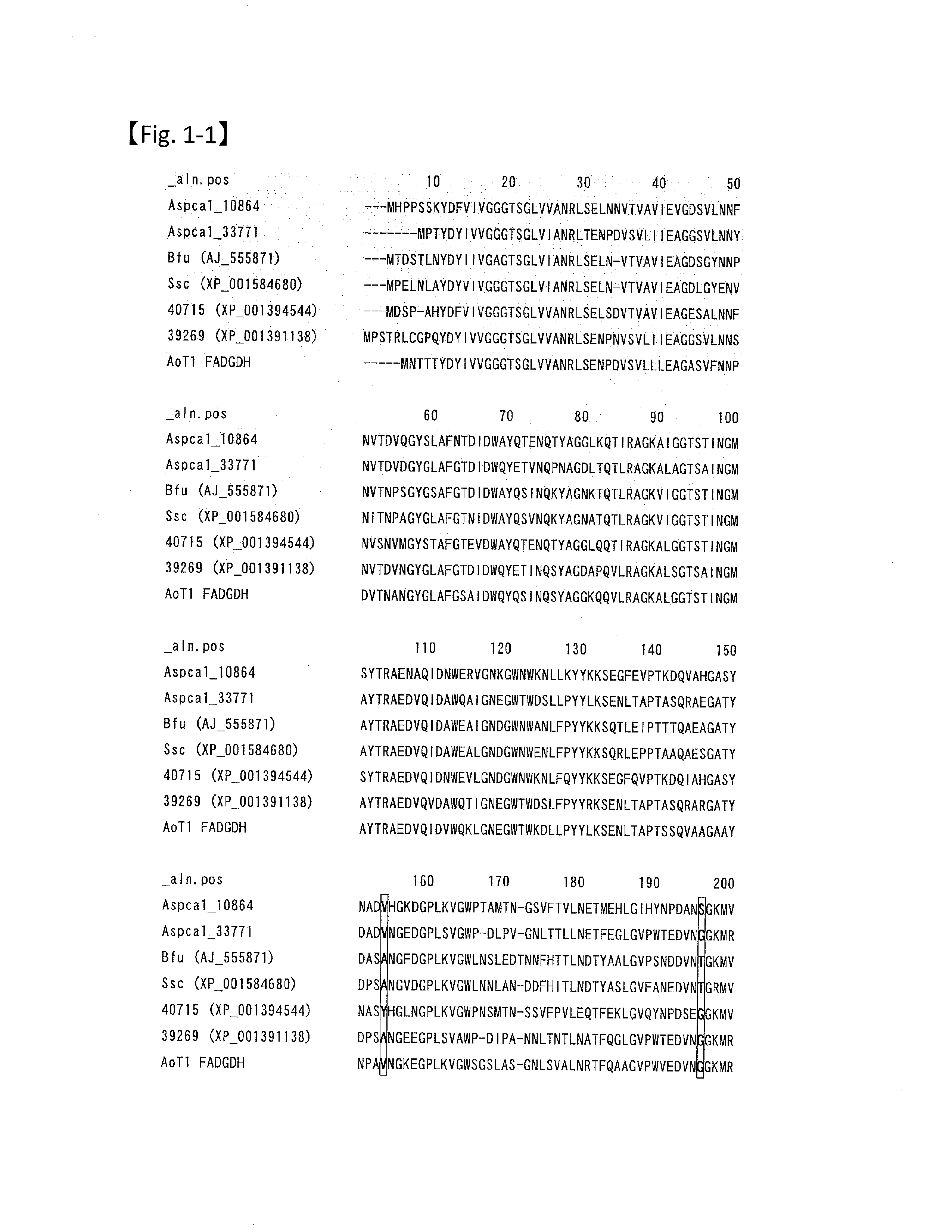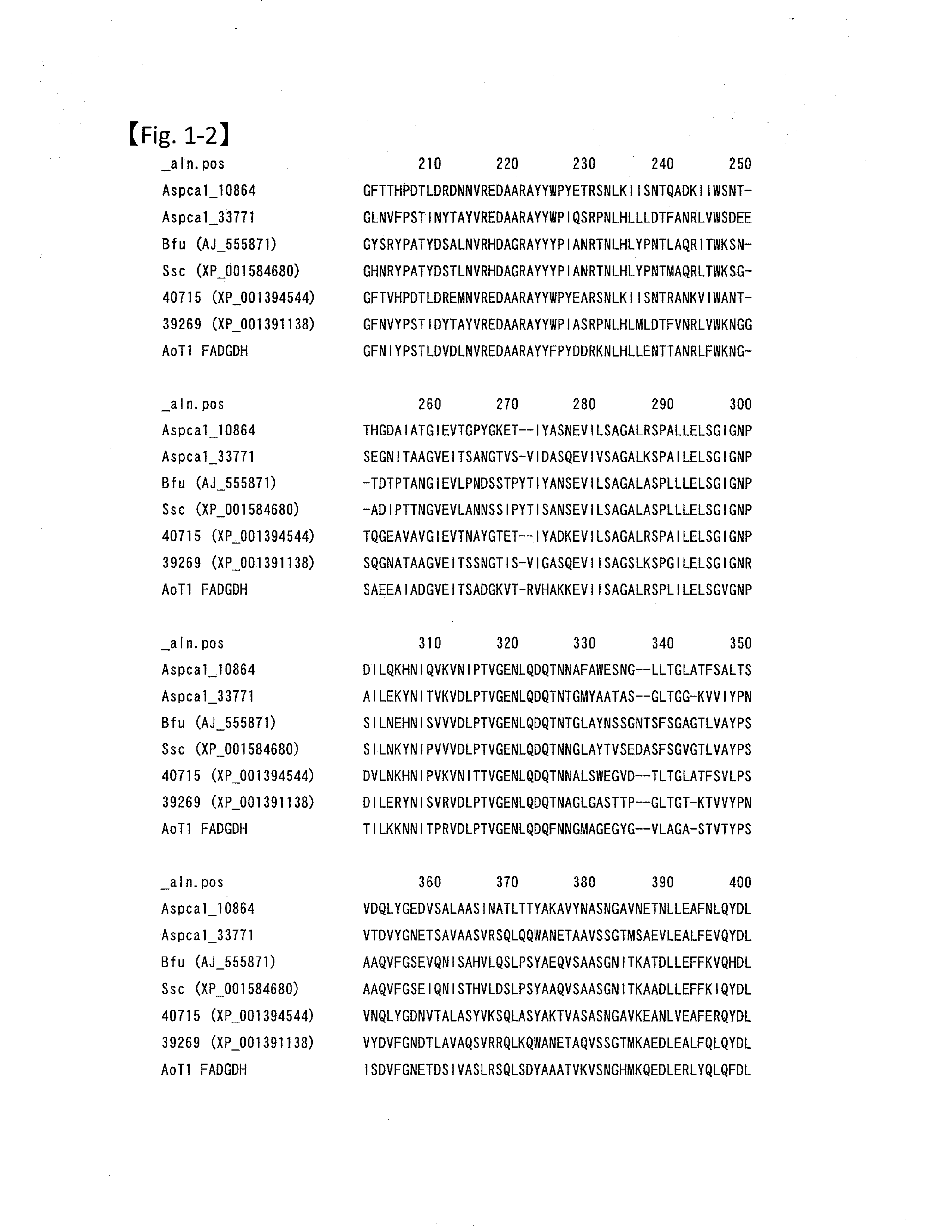Glucose dehydrogenase
a technology of glucose and dehydrogenase, which is applied in the direction of dna/rna fragmentation, immobilised enzymes, diaphragms, etc., can solve the problems of low selectivity for glucose, complex detection system, and influence of dissolved oxygen level in analyte data, so as to achieve higher thermal stability and productivity. high
- Summary
- Abstract
- Description
- Claims
- Application Information
AI Technical Summary
Benefits of technology
Problems solved by technology
Method used
Image
Examples
example 1
Preparation of Recombinant Genes of Glucose Dehydrogenase from Botryotinia fuckeliana (Bfu-GDH) and Glucose Dehydrogenase from Aspergillus oryzae (Ao-GDH)
[0069]The amino acid sequence of glucose dehydrogenase from Botryotinia fuckeliana is shown in SEQ ID NO:1. The region from the N-terminus to Ser at the position 17 is assumed to be the signal peptide. For example, the free access server SignalP 3.0 Server (http: / / www.cbs.dtu.dk / services / SignalP-3.0 / ) can be used for predicting the signal sequence cleavage site. This server is operated by The Center for Biological Sequence analysis at the Technical University of Denmark, and conducts a search for potential signal sequences in a given amino acid sequence, and predicts the cleavage sites for the sequences based on the methodology described in the following report: “Identification of prokaryotic and eukaryotic signal peptides and prediction of their cleavage sites,” by Henrik Nielsen, Jacob Engelbrecht, Soren Brunak and Gunnar von Hei...
example 2
Measurement of Enzyme Activity
[0071]Measurement of the glucose dehydrogenase activity of the FAD-GDH of the invention was carried out by quantitatively measuring the change over time in absorbance at 600 nm, which indicates the color fading of 2,2′-dichlorodiisopropyl ether (DCIP) reduced by the reaction of the dehydrogenase with the substrate. Unless noted otherwise, the reaction was carried out under the following conditions. The reaction was initiated by adding substrate to the reaction solution containing the enzyme (10 mM potassium phosphate (pH 7.0)+0.6 mM PMS+0.06 mM DCIP; the concentrations are indicated as final concentrations), and the change in absorbance at 600 nm was monitored. Glucose having a final concentration of 50 mM was used as the substrate, and the amount of enzyme which reduces 1 μmol of DCIP was defined as 1 unit. The activity was calculated with the following formula. The molar absorption coefficient of DCIP at pH 7.0 was set to 16.3 mM−1 cm−1.
unit / mL=ΔABS / m...
example 3
Investigation of Culturing Conditions, and Production of Partially Purified Enzyme Preparation
1. Production of Bfu-GDH Using IPTG Induction:
[0073]E. coli BL21(DE3) was transformed with the expression vector pET30c bearing the gene coding for Bfu-GDE. The resulting transformant, BL21(DE3) / pET30c(Bfu-GDH), was inoculated into 3 mL of LB medium and cultured with shaking at 37° C. overnight. Next, 1 mL of pre-culture solution was inoculated into 100 mL of LB medium (kanamycin (Km, 50 μg / mL) and cultured with shaking at 37° C. and 180 rpm using an Erlenmeyer flask with baffle. When the OD660 value for the culture solution approached 0.6, isopropyl-β-thiogalactopyranoside (IPTG; final concentration, 1 mM) was added to induce Bfu-GDH expression. Following addition, culturing was continued at 20° C. and stopped 14 hours from the start of culturing. During culturing, 300 μL of the culture medium was taken once every several hours, 60 μL of BugBuster Reagent was added to the collected cells, ...
PUM
| Property | Measurement | Unit |
|---|---|---|
| Fraction | aaaaa | aaaaa |
| Mass | aaaaa | aaaaa |
| Mass | aaaaa | aaaaa |
Abstract
Description
Claims
Application Information
 Login to View More
Login to View More - R&D
- Intellectual Property
- Life Sciences
- Materials
- Tech Scout
- Unparalleled Data Quality
- Higher Quality Content
- 60% Fewer Hallucinations
Browse by: Latest US Patents, China's latest patents, Technical Efficacy Thesaurus, Application Domain, Technology Topic, Popular Technical Reports.
© 2025 PatSnap. All rights reserved.Legal|Privacy policy|Modern Slavery Act Transparency Statement|Sitemap|About US| Contact US: help@patsnap.com



